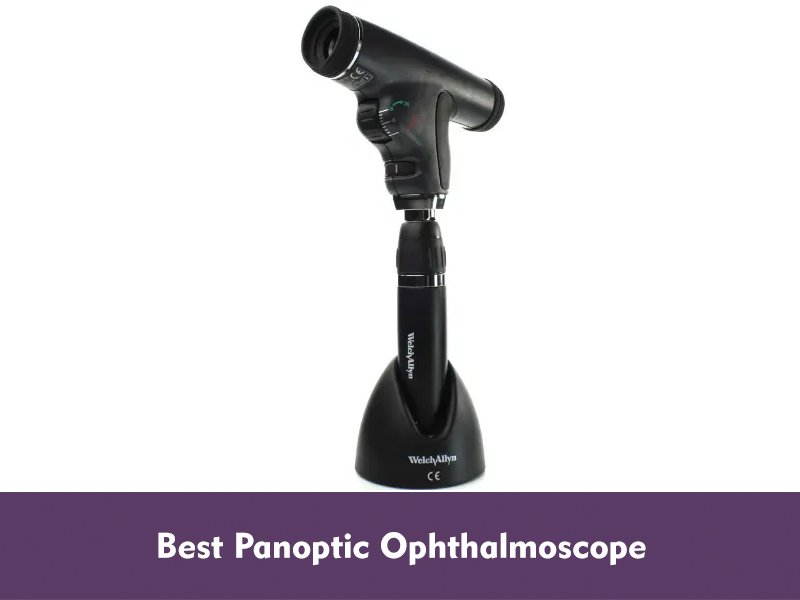Do I need a Panoptic Ophthalmoscope? Ophthalmoscopy is a test to check the health of the eye. It analyzes the fundus of the eye and gives doctors an idea about eye health. Ophthalmoscopy is also called funduscopy. Advancements in science have allowed doctors to create newer and better ways to retain results regarding eye health. A Panoptic Ophthalmoscope can be used to check the health of the eye without dilating the pupil. The entire procedure is part of a routine physical checkup.
Panoptic Ophthalmoscope helps doctors examine the eye 5x times better than a regular tool. The device can help give an adequate view of the fundus. As a result, the health of the retina and optic disk can easily be determined. This helps doctors provide a successful diagnosis. It is certainly a significant improvement in healthcare. Consequently, it provides images of the macula, fovea, and posterior pole through the pupil.
Doctors view the interiors of the eyes through the pupil. When using a Direct ophthalmoscope, the pupil needs to be dilated. Since the dilation results in enlarged pupils, doctors get a clear view of the eye. But a Panoptic Ophthalmoscope is a more straightforward method because you do not have to dilate the eye. By providing a better image, doctors can check the characteristics of the eyes. Moreover, the tool helps to examine the blood vessels, blood pressure, or even diabetes.
What is a Panoptic Ophthalmoscope?
To inspect the back of the eyes, doctors use the standard procedure of ophthalmoscopy. Ophthalmoscopy is a meticulous process. The tool used is called an ophthalmoscope and has always proved to be an efficient tool. However, The problem with this tool is that the eye has to be dilated before use. While waiting for the dilation, doctors and patients face unnecessary expenses and time consumption. It delays medical assistance and often becomes a challenge for doctors. To solve this, the Panoptic Ophthalmoscope has been adopted by eye doctors around the world.
A doctor’s job has become easier with the use of the panoptic ophthalmoscope. The fundus can be viewed and captured digitally using the Panoptic Ophthalmoscope. Images on a Panoptic Ophthalmoscope can be shared and stored. As a result, doctors can process an elaborate examination of the eye.
The tool used in a Panoptic Ophthalmoscope provides the user with a 25º field of view. This makes the image 5x more significant than a direct ophthalmoscope. The Axial Point Source Optics present in the PanOptic Ophthalmoscope allows a doctor to easily detect diabetic retinopathy, glaucoma, and hypertension changes from the eye, thus speeding up the diagnostic process. The Panoptic Ophthalmoscope can also be used to indicate a brain tumor, intracranial hypertension or find swollen optic discs.
What Makes A Panoptic Ophthalmoscope Different?
The main functions of a Panoptic Ophthalmoscope are to check your eyes. Doctors examine conditions that might affect the blood vessels, such as:
- Optic nerve damage
- Tears or detachment on the retina
- glaucoma or pressure in the eyes
- muscle degradation or loss of vision
- infections in the retina
- melanoma, a kind of skin cancer which spread to the eyes
- hypertension
- diabetes
Much like the traditional Ophthalmoscope, Panoptic scopes have similar components. For instance, the light source, viewing aperture, a filter dial and focus dial for different lenses are present. The technology used in a Panoptic Ophthalmoscope provides a more reliable source of illumination. This is very useful when checking the eye. The different light filters allow images to be taken in light or darkness.
Dilation of the pupil is not required when using the device. The focusing dial and lens bank is used to bring the structures into focus during the examination. This means the margin for error is much less when using a Panoptic Ophthalmoscope.
How Do You Use A Panoptic Ophthalmoscope?
The methods used to examine a patient with this device is similar to a direct ophthalmoscope. Firstly, the room must be prepped for the examination. Secondly, The lights are dimmed, and the patient must be comfortably seated with the examiner at the same level of height.
Thirdly, It is essential to hold the device in the same sided hand as the eye being examined. The left eye must be tested using the left hand only. This provides a sturdy and more efficient process. Lastly, The patient is told to focus on a consistent point, a meter in the distance ahead. A red light is reflected into the eye of the patient, and his red reflex is tested. Once completed, the doctor uses the Panoptic Ophthalmoscope to illuminate the patient’s eye.
Although the point of the device is that pupil dilation is unnecessary, a doctor can administer the drops for the same, if required. Both the doctor and patient must not use eyewear during the procedure. If the doctor is nearsighted, an exception can be made.
A Deeper Understanding
Through the viewing aperture, the R/R is analyzed, and after achieving this, the lens is adjusted to +10 diopters. The doctor moves towards the patient until he is close enough to secure a proper reading. The doctor then moves the lens dial from +10 to 0 diopters and shifts the focus from the front to the back of the patient’s eye. From here, the doctor can easily view the interior spots behind the retina.
The eyecup is compressed against the patient’s brow for a comprehansive view. As mentioned above, the field of view is 25°. The optic disc can be examined, and the doctor gets more clarity on the colour, elevation and condition of the blood vessels. You can analyze each vessel as far as the periphery goes. To locate the macula, move the light one diameter temporally after focussing on the disc. Once you examine the macular area, you will get a general idea of the abnormalities present.
Top Panoptic Ophthalmoscopes
If you are a doctor looking for a reliable tool, you need to know about the device you are purchasing. Here’s a list of the best devices you can find in the market:
-
Welch Allyn PanOptic Smart Set 97800-MS
- Halogen light for inspection
- Very long-lasting
- Wide-angle feature
- Very accurate reading
2. Welch Allyn Premium Diagnostic Set feat. Coaxial Ophthalmoscope, PanOptic Ophthalmoscope
- Learn and perfect the eye and ear exam with a trusted set of diagnostic equipment owned by 95% of US physicians. Our Premium Set includes two...
- The Welch Allyn PanOptic Ophthalmoscope has a 5X wider field of view, allowing you fast, easy entry into the eye. The Welch Allyn Coaxial Ophthalmoscope...
- The Welch Allyn MacroView Otoscope supports a bigger, better 2X larger field of view of the tympanic membrane with the widest focal range of any otoscope;...
- Welch Allyn Lithium Ion Handles are lightweight and power 3.5 V Welch Allyn instrument heads for 120 minutes—twice as long as a conventional handle
- This product is intended for sale to and for use by Medical Professionals/Educators and students who are under the training or supervision of Medical...
- A better view of the Fundas.
- Super bright LED light
- Dynamic focus wheel and precise
- Lithium handles are lightweight
- High magnification
Pros And Cons of Panoptic Ophthalmoscope
While, an Ophthalmoscopy can be uncomfortable; however, it should never be painful. Though afterimages are a common effect of the process, they disappear when you blink continuously.
In particular, a Panoptic Ophthalmoscope helps avoid this problem. It also prevents dizziness and nausea.
The process is also quicker and provides a faster reading for the doctor. This not only speeds up the medical procedure but also saves time and money.
Besides, a Panoptic Ophthalmoscope provides a broader view. It is 5x times better than a direct Ophthalmoscope. As a result, it is easier for doctors to get a precise idea of the eye’s health.
However, as compared to a direct device, a Panoptic Ophthalmoscope is expensive. But with the advantages present, it is clear that the price should not matter as medical equipment can save a life. Undoubtedly, the Panoptic Ophthalmoscope provides efficient and effective results. In effect, it greatly increases the possibility of retaining a patient’s vision.
Why A Panoptic Ophthalmoscope Is Better Than A Conventional Direct Ophthalmoscope
The Panoptic Ophthalmoscope is more reliable and efficient than the conventional tool. The device provides a better view of the eye interior and reduces examination time for doctors. Therefore, it saves time and money allowing you to speed up the process.
Because dilation drops are unnecessary, you avoid the after-effects like nausea and dizziness. Hence, it is preferable for patients that are allergic to the drops.
The medication procedure is quicker, and the Panoptic Ophthalmoscope has proven more reliable for eye examinations. The direct Ophthalmoscope is cheaper and handy to carry around. The tool is a better choice for traveling doctors. However, if you order a Panoptic Ophthalmoscope with a hard case, you can still travel comfortably with your device.
In the design, the focus wheel, illumination, and lens are much better in a Panoptic Ophthalmoscope. Doctors can adjust the strength of the lens smoothly and securely. The results are precise and immediate and because of this, patients do not need to wait until their eyes dilate.
Due to the fixed distance between the doctor and the patient, the device makes the process comfortable. Moreover, the eyecups help examine the patients. The light allows a doctor not only to examine the patient more comfortably but also ensures the best results. Besides this, the design with the handle also provides a better grip.
The digitalization of the Panoptic Ophthalmoscope allows doctors to take images of the eye interiors. Medical experts store these images for future use. As a result, they get more time for a precise diagnosis to take place. Additionally, doctors and professors can use these images to explain ailments to students.
FAQs
1) Is it worth the money or should I get a regular Ophthalmoscope?
A) The Panoptic Ophthalmoscope is more precise than a regular device. It is sure to set you apart from the rest and have your fellow doctors wanting to try it out.
2) What are the significant differences between standard ophthalmoscopes and a PanOptic Ophthalmoscope?
A) The view from a Panoptic Ophthalmoscope is 5x broader, and thus, more efficient than a direct device. Because of this, the view field is 25° against the 5° field standard view. The result is a 26% increase in magnification with which doctors can provide a better diagnosis. There is also more distance between the doctor and patient, thus making it more comfortable to use.
3) How do I clean the device?
A) You can disinfect the device with a cloth. You can use alcohol to moisten the lens.
4) Can I replace the light bulbs in the device?
A) The lightbulbs in the device are replaceable. The halogen light is available in the link above.
Final Words
The Panoptic Ophthalmoscope is easily a better choice for doctors and hospitals are opting for the new device. The Panoptic Ophthalmoscope has proven to be more efficient in every possible. It provides a more comfortable scenario for you and your patients with an accurate reading. Choose the product that suits your requirement from the list above.

Dr. David Taylor is a medical professional and an avid blogger. He holds an M.D. from Drexel University & a Ph.D. from Indiana University School of Medicine.
Dr. David loves to utilize technology to improve healthcare and he does it daily through BestRatedDocs.com. He founded the company in 2016 with the vision to make the discoverability of the best healthcare facilities & best products simple and easy. His passion for informatics and using technology to empower healthcare professionals and the patients they serve is unmatched. He regularly blogs about technology, health IT, medical products and other healthcare topics at bestrateddocs.com.
Last updated on 2025-11-12 // Source: Amazon Affiliates



